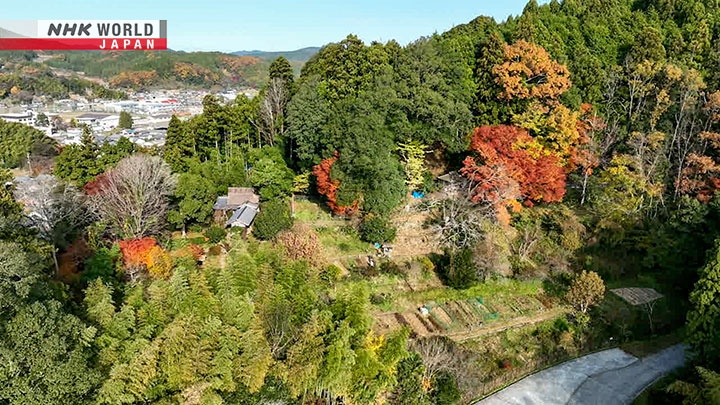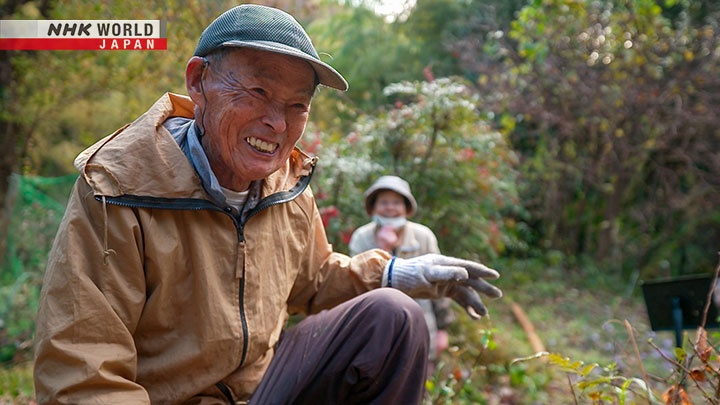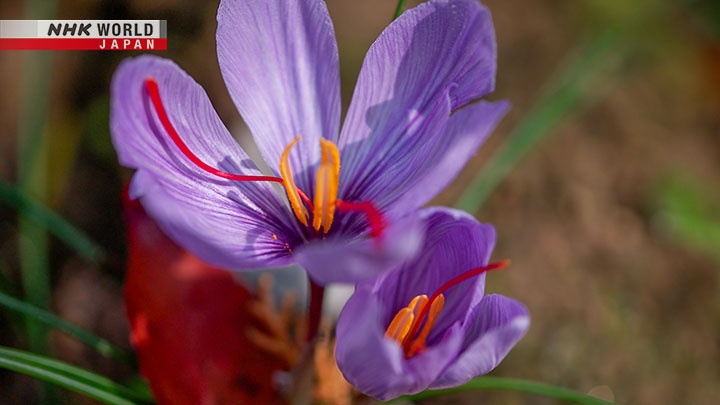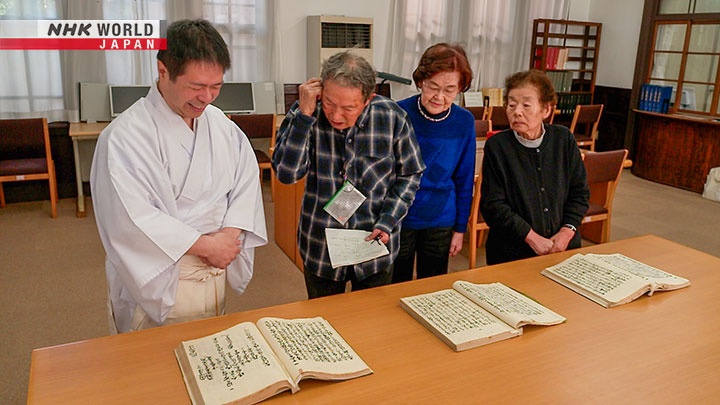Second Movement
An autumn visit of Japan's oldest private medicinal herb garden where nature from 300 years ago is preserved in a botanical time capsule of culture and history.




Transcript
Uda in Nara Prefecture.
From time immemorial, this land has been known for its abundance in medicinal plants.
More than a thousand years ago,
this very region was where medicinal ingredients were gathered for the imperial court.
It's also home to the oldest privately-owned medicinal herb garden in Japan.
Here, medicinal herbs and trees planted three centuries ago still grow.
Let's take a peek at this botanical time capsule.
In charge of managing the medicinal herb garden,
Harano Etsuro works here every day, except when it rains.
Job's tears. Pigeons love it.
It's well-known for treating warts.
It survived the typhoons we had this year.
I'm relieved I can collect some seeds.
Autumn is harvest time here in the garden, too.
Autumn, season of blessings.
Here and there, the garden is adorned with plump and brightly-colored fruit.
This is Etsuro's wife, Hideko.
Autumn is also a time when they prepare for the sprouting of new shoots.
We've planted some "Adonis multiflora."
There should be some new shoots.
I just love gardening. I can't really say why.
I didn't play in a garden as a child.
Somehow, I came to like gardening.
"Maybe it's thanks to your husband?"
I guess.
Here, I'm preparing the soil for some ginseng.
I put a lot of effort growing ginseng here over five years.
But the landscape gardener took down a nearby tree, and it accidentally fell...
on top of the ginseng. We lost all of it.
The garden's founder, Tosuke, had been growing ginseng for the shogunate.
So, I want to contribute to the garden by growing some, too.
I enjoy it, but I also worry about it...
as I prepare the soil.
The medicinal herb garden was founded by Morino Tosuke.
Around three centuries ago, he set it up in the woods behind his residence.
In the Edo era, when Japan was plagued with infectious diseases,
the shogunate put its hopes in the cultivation of medicinal plants to save the people.
The Morino garden was thus established to assist in that endeavor.
Around seven hundred species of medicinal herbs and trees were planted.
Tosuke grew medicinal plants for the shogunate
and kept a detailed illustrated record of every species to ensure their posterity.
The garden still looks as it did back then.
More than two-hundred-and-fifty kinds of rare medicinal plants remain well-rooted in the soil today.
Over generations, the Morino family has been looking after the garden.
Teruko took over the administration when her husband passed away twenty years ago.
She entrusted the garden's management to Etsuro and Hideko.
It's been three hundred years.
Each plant is very precious. Mr. and Mrs. Harano preserve them.
I'm infinitely grateful for their hard work.
I hope the garden will be preserved for generations.
The couple live about a five-minute bicycle ride from the garden.
I carefully choose the best seeds.
I leave them for next year.
Silly me! I forgot the lid.
Nothing better to celebrate the harvest than a cup of the secret to their good health -
homemade herbal tea.
It's nice and mild.
It's OK.
Has it started to grow?
This is ginseng.
This one's gotten bigger.
Luckily, I'd kept some seeds from the garden.
I grow some of the plants here, too.
Like the Morino garden supported the shogunate, I play a similar role...
by growing plants here, too.
During the Edo era, the root of ginseng was highly valued for its multitude of beneficial effects.
Tosuke was given a hundred seeds by the shogunate,
which he grew in the garden to keep a reserve should a shortage occur anywhere else in the country.
Maintaining the garden would be impossible without the neighbors' help.
Good morning!
The three helpers learn the art of cultivating medicinal herbs from Etsuro.
Can you plant them here?
We need to add straw.
Some cut-up straw?
Straw ash, actually.
Better write this down.
I don't want to forget anything.
It's a jewel beetle larva.
This isn't a place for you!
The rotting trunk of a hackberry is a good environment for it.
They're carving out a home for it.
Wow!
Here's a comfy spot to safely spend the winter.
We're going to plant some ginseng.
First, we prepare the soil.
We plant it then leave it for 4, 5 years.
Gradually, the fertilizer takes effect. We consistently add some.
It's soft and light.
- When was this one planted?
- Three years ago.
From the fourth year, it bears red fruit.
It's a medicinal herb that's very troublesome to grow.
That somehow fits its reputation as one of the top medicinal plants.
Alright! Planting's done.
Thank you so much!
They look great!
With the garden at its heart, medicinal herbs and their traditions have taken root in the local community.
I'm getting used to it.
Like a pro!
They grind boiled soybeans and job's tears seeds.
Some rice malt and job's tears malt are crushed then mixed with salt.
All the ingredients are fermented over 1 or 2 weeks.
Magnolia leaves are softened in hot water.
It's delicious. Nice aroma.
What gives it this sweetness?
Maybe the job's tears malt.
It's quite mellow.
It's got a unique aroma.
A taste of autumn.
In Chinese mythology is a deity called Shennong.
It's said that he would taste a hundred plants a day,
often stumbling upon poisonous ones, in order to discover medicinal plants.
Wasn't it Paracelsus who once said, "the dose makes the poison?"
This is monkshood.
It's poisonous, but it's also used for its heart-strengthening properties.
This is "Isodon japonicus."
It's very bitter.
Bitter medicine is good for digestion.
Let's have a taste.
It's bitter, isn't it?
They say it was so bitter, the sick would suddenly get up.
It's an old legend.
This is a medicinal evodia.
It was given by the shogunate long ago. I've been taking great care of it.
It's really bitter, like most stomach medicine.
Taste a hundred plants to find one medicine.
Some say the best medicine tastes the worst.
It would seem this applies to the medicinal plants in the garden, as well.
Near the garden is a public farm that was set up
to help people familiarize themselves with medicinal herbs.
It's quite popular with locals eager to learn from Etsuro's extensive knowhow.
The sticky sap.
It has medicinal effects.
I'm so sure why, but there's a legend.
It says Shennong noticed that, when animals got hurt or sick...
they'd instinctively ate this to treat themselves.
So, he figured it could help treat conditions in humans, too.
That's the origin of this plant's use.
It's delicious.
It feels great to take care of this medicinal herb farm.
Everyone has a great time here.
Mr. Harano...
He has knowledge no one else has of medicinal plants and how to grow them.
He's invaluable to this region's medicinal herb farming.
The saffron has begun to bloom.
Its bright red stigmas are used as both medicine and spice.
Turmeric seed potatoes.
Today was the first frost of the year.
We need to protect these today or tomorrow.
Weak to the cold, turmeric is preserved through winter following a traditional method that makes use of natural heat.
We use the earth's warmth, which is about 14℃.
As they go through winter, I find them so cute, I pet them.
My little darlings.
New visitors arrive.
Good morning.
The garden's medicinal herbs draw in people from all walks of life.
The saffron is almost in full bloom.
So beautiful!
Wow!
These required the most work.
Take one.
Turmeric for your curry.
- Can I take a bite?
- Sure.
Amazing! It's so fresh.
I never tasted it like this.
Eating it raw, the spiciness and aroma are quite different.
What a surprise.
Most people only get to see herbal medicine after it's dried.
So, being able to see the ingredients as they are cultivated...
is a learning opportunity.
When we moved to Uda...
we saw medicinal herbs being grown and used here.
I wanted to use some in my curry.
What looks like weeds are in fact herbs.
Once I knew that, I began to realize we're surrounded by medicinal herbs.
We want to make them a part of our lives.
The Japanese angelica that was planted in early spring is harvested in winter.
It's long been treasured as a specialty of the Uda region.
The roots are very important. Gotta be careful not to break them.
To protect the "Adonis multiflora," we cover them with dead leaves.
- "Do you like" Adonis multiflora?
- Yes.
They're beautiful and delicate flowers.
She likes them! But more than that, she's an expert about vegetables.
I'm the medicinal herbs expert.
We complete each other.
You can look forward to it.
They're the first flowers to bloom in the new year.
Etsuro has a wish he's held dear to his heart for many years.
It's a history treatise of Japanese medicinal herbs.
The founder, Tosuke, went to seek out herbs...
with herbalist Uemura Saheiji.
Records say he planted Japanese cornel trees at Ise Jingu Shrine.
Under an assignment by the Edo shogunate, the garden's founder, Morino Tosuke,
journeyed through the land with a herbalist in search of medicinal plants.
That was when illness had been taking the lives of many people throughout the country.
The group stopped by Ise Jingu Shrine to plant medicinal trees including Japanese cornel.
It is said that the origin of Ise Jingu Shrine dates back more than two thousand years.
As a central hub to all shrines throughout Japan,
anyone in the Edo era wished to visit Ise Jingu at least once in their lives.
That's where Tosuke and his team planted the medicinal trees.
But he did more than just plant them.
When he learned some trees had died later, records say he went back...
to plant a new cornel tree.
I may not have the same passion and devotion as Tosuke did.
But I'd like to go there and check for myself.
Can the trees Tosuke planted still be found today?
Etsuro has been modestly growing the very same three varieties on his own.
It's been ten, fifteen years.
I did it on my own initiative, just in case.
If the trees Tosuke planted at the shrine turned out to be dead...
new ones can be planted.
This is my small wish for the future.
I've devoted half my life to medicinal plants.
That may sound a bit boastful.
There are no such things as weeds.
Each and every medicinal plant is imbued with life.
Just like Tosuke kept medicinal plants and their culture alive,
Etsuro too wishes to preserve them for future generations.
This Japanese cornel...
was bestowed by the shogunate in 1792.
Tosuke went to Ise Jingu to plant its seeds.
I want to go see those trees as proof of Tosuke's life and achievements.
Before the New Year, I decorate it...
in thanks for another year.
It's also to pray for the garden to live on forever.
Tondo Yaki ceremony.
Last year’s good-luck amulets are burned to pray for good health in the New Year.
Shepherd’s purse.
Some water dropwort.
They're wild plants.
I enjoy looking for them every year.
In this cold wintery land, the soil beneath one's feet is like a treasure trove.
"Shepherd's purse, seven herbs. Misfortune, fly away with the birds."
On the seventh day of the year, the custom is to prepare a special rice porridge with seven medicinal herbs.
As a prayer for good health and no misfortunes for this new year...
we have seven-herb rice porridge.
I don't like it when it's too hot.
Hi!
Masanori helps Etsuro with the garden.
I'm preparing hot water.
I'd like you to teach me.
They're going to press angelica in hot water.
Why do we do this?
With photosynthesis, the plant built up starch.
In other words, sugar.
We help turn the starch into sugar.
We do this by pressing it in hot water.
Nowadays, we don't do this.
We just ship the angelica as is.
Because this is too troublesome.
But I know of the tradition of pressing the plant in water before selling it.
So, I want to do it, too.
It's the same for other old traditions. I might not be able to do all of them.
But I should start with the small ones and pass them on.
Through generations, the Morino Family has preserved the garden's legacy.
On the 15th day of the year, they prepare another type of rice porridge, this time with adzuki beans,
which are said to ward off evil, and offer it to their ancestors.
It's to pray for safety and health for our family.
It's also a prayer for abundant crops for the year.
We've kept this tradition of offering adzuki rice porridge.
We do it every year with gratitude...
and respect for our ancestors.
For around four hundred years,
the Morino family have been producing starch from the roots of kudzu, also called Japanese arrowroot.
Records from that period show that the kudzu starch from this region,
named "Yoshino," was of high quality.
Long ago, in winter, many specialists would look for kudzu in the mountains of Yoshino.
However, very few such experts can be found in the area today.
Fallen leaves.
Nothing much here.
This is no good.
What happened?
In summer, I look for kudzu with lots of leaves as photosynthesis...
promotes the production of starch.
But in winter, we have to dig.
These are all kudzu leaves.
- "Is that a kudzu tree?"
- Yes, it is.
It's got plenty of starch.
If you press it like this.
See those white bumps?
This is the starch.
From now until February, this is the best season.
Kudzu is often cast aside as an undesirable plant.
But deep within the soil, they hide a treasure.
After resting for 3 days, unrefined starch has formed at the bottom.
A doctor knows about the kudzu in Yoshino.
He said, "Drink it in hot water."
I haven't had a cold in decades. I'm not sure why. I'm no doctor.
At the Morino factory, cold water is added to the unrefined starch.
The kudzu starch, aptly nicknamed "white diamond," is finally ready.
This handmade process is invaluable.
It continued through our ancestry.
It's very important to keep doing it with the most meticulous care.
I hope it continues on to future generations.
Good morning!
Three centuries ago, to heal a nation from illness,
the Morino Garden was established then preserved over time including a Japanese cornel tree.
Do its counterparts planted then re-planted in Ise Jingu Shrine by Tosuke still remain to this day?
- Good morning.
- Hi! I'm Nakanishi.
- Pleased to meet you.
Let me be your guide.
We've finally arrived.
This is the main sanctuary, the central part of Ise Jingu.
When the first medicinal trees were planted some 280 years ago...
the sanctuary was as it is now.
Morino Tosuke came to the shrine and planted the trees...
then later planted a new one.
Nakanishi takes them to the spot thought to be where Tosuke planted the trees.
This is the most sacred area of the sanctuary, where the deity is enshrined.
We believe the trees were planted somewhere near the western side...
of that fence over there.
We think visitors who came from all over Japan...
could also see the trees Tosuke planted.
Unfortunately, it seems that the trees are no longer here...
in either of the shrine's sanctuaries.
Still, Etsuro looks for traces of Tosuke's passage.
I think he planted five trees of each kind at different spots.
He combs through the sanctuary grounds to be sure not to overlook anything,
not even a single lost sapling.
We're pretty far from where the trees were planted.
It's too bad.
But the shrine's archives still hold records of Tosuke's visits.
This is the journal of the head priest in 1743,
the year when Tosuke and his team came to the shrine.
I was doubtful at first, but I searched.
And I found a record.
We're quite amazed to have found this.
Long ago, only the emperor was allowed to make an offering to the deity at Ise Jingu Shrine.
Until today, bringing in trees to be planted on the sacred courtyard of the shrine
has been a very rare occurrence.
Back then, and even now, it very seldom happens...
that someone who doesn't belong to the shrine makes an offering.
But maybe because it was by order of the shogunate...
preparations had been done to welcome Tosuke to the shrine.
They prepared signs for each kind of tree.
They took detailed records.
Then five months later, Tosuke came back.
I'm so thankful that the records were kept in such detail.
For three years, we too suffered from the COVID pandemic.
We can understand Tosuke's strong wish for the trees to help people recover.
Especially since he came back twice to plant new trees.
To be able to see this now three centuries later...
I'm deeply moved.
This gives me a better understanding of the life of the first-generation Tosuke.
He eagerly wanted to help others through medicinal herbs.
And now, we preserve the garden to keep his wish alive.
I wasn't sure it was possible, but I hoped to find...
traces of his passage here, which I saw in this journal.
This gives me a much clearer image of his journey to the shrine.
Thank you so much.
Thank you so much for your time on a cold day like today.
Thank you.
This is from the Morino Garden.
They're seeds from the Japanese cornel planted 300 years ago.
These and the seeds Tosuke planted here are from the same tree.
I'd appreciate it if you could plant them in a pot, perhaps.
You made my long-time wish come true.
May you have a long life and continue your amazing work.
Retracing the footsteps of Tosuke who brought medicinal trees hundreds of years ago,
Etsuro entrusted new seeds to the shrine.
The "Adonis multiflora" announce the end of winter.
Such a vivid yellow.
They're delicate flowers.
The "Adonis multiflora" bring memories of spring.
It's exciting.
Many other plants have started to grow.
This is a time when we have to put in our best effort.
They haven't come out.
We have to be patient and wait for them to grow.
It's an exciting time, but it's also a season of patience.
The Morino family, along with Etsuro and Hideko,
keep the legacy of the medicinal herb garden alive.
The seeds first planted by Tosuke, the garden's founder, continue to grow today.
Then, as always, spring returns to the garden, and nature's cycle begins anew.
Thank you so much.